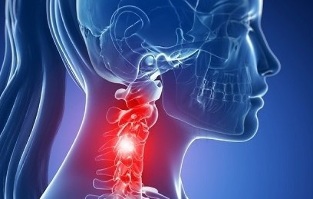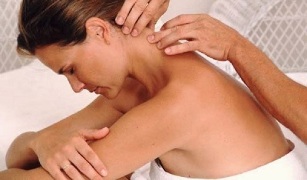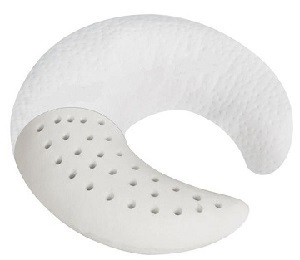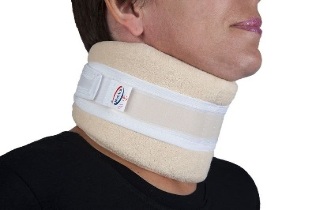
Osteochondrosis is a degenerative-dystrophic disorder of the intervertebral discs, and the cervical region is the most vulnerable part of the spine, which has an anatomically different vertebral structure, is very close to each other, and has a weak ligament. Therefore, even with small additional loads, the vertebrae may move, leading to compression of the blood vessels and nerves.
And because the vertebral arteries involved in the blood supply to the brain pass through the holes in the transverse processes of the vertebrae at this stage, the vertebrae pinch orcompression of holes by overgrown osteophytes has very serious consequences.
What's this?
Osteochondrosis of the cervical spine is caused by a polyetiological progressive disease with degeneration of the intervertebral discs and degeneration of the spinal cord device.
CausesThe main causes and preconditions for the occurrence of osteochondrosis of the cervical vertebra are:
- Curvature of the spine, scoliosis.
- Stress, nervous tension negatively affects the general condition of the body, can cause osteochondrosis of the cervix.
- Previous infectious diseases often become the cause.
- Improper, uncomfortable posture during sleep (such as an uncomfortable pillow).
- Congenital problems or hereditary diseases of the cervical spine.
- Poor posture in young people and adolescence.
- Overweight, varying degrees of obesity. The extra pounds increase the load on the vertebrae and discs, leading to degenerative processes.
- Back injuries in childhood or adolescence.
- Disruption of metabolic processes.
- Work related to physical work that can provoke diseases of the spine in different parts of it.
- Inactive lifestyle, sedentary work, improper exercise.
For successful treatment of cervical osteochondrosis, the cause of the occurrence, the prerequisites for its development, must first be identified and eliminated. Until recently, the disease only occurred in people over 45 years of age. Now young people are exposed, the age group is 18-25 years old.
Cervical spine characteristics
Examine whether the cervical spine is different from the rest of the spine and whether osteochondrosis is a prerequisite for the development of these syndromes.
- The cervical region contains important ganglia (nodes) of the autonomic nervous system.
- Transverse processes in the vertebrae have holes that form a channel through which the vertebral artery passes, delivering oxygen and nutrients to the brain, cerebellum, auditory organs, and vertebral nerve as well. These are prerequisites for frequent entrapment of the artery and nerve.
- The cervical spine is the most mobile. It is characterized entirely by all types of movement. These are prerequisites for frequent violations and subluxations.
- The intervertebral foramen of the lower three vertebrae is not round but triangular. These are prerequisites for pinching nerve roots by bone growth in osteochondrosis.
- The intervertebral discs are not the full length between the vertebral bodies. In the anterior part, instead, they have protruding edges of the vertebrae, which are connected by joints. These are prerequisites for the occurrence of joint subluxation.
Development Stages
The extent of osteochondrosis is determined by the clinical picture and the patient's complaints. The concept of grade should not be confused with the stages of osteochondrosis. The sections are discussed below.
- First degree. Clinical manifestations are minimal, the patient may complain of low-intensity cervical spine pain, which may be exacerbated when the head is turned. Physical examination may show mild muscle tension in the neck.
- Second degree. The patient is concerned about the pain of the cervical spine, its intensity is much higher, the shoulders and arms may be irradiated. This is due to a decrease in the height of the intervertebral disc and pinching of the nerve roots. Painful feelings are exacerbated when the head is tilted and turned. The patient may experience decreased performance, weakness, headache.
- Third degree. Symptoms of cervical osteochondrosis increase, and the pain becomes permanent with irradiation of the arm or shoulder. Numbness or weakness appears in the muscles of the arm as herniated intervertebral discs form. She is worried about weakness, dizziness. The test shows limited mobility of the cervical spine, pain when touching the cervical spine.
- The fourth degree. There is complete destruction of the intervertebral disc and its replacement with connective tissue. It increases dizziness, tinnitus, impaired coordination, as the process involves the vertebral artery, which feeds the cerebellum and the occipital lobe of the brain.
Symptoms
The severity of the symptoms of cervical osteochondrosis depends on the degree of destruction of the vertebral structures. Symptoms are exacerbated by the growth of bone tissue with the formation of osteophytes, radicular syndrome (radicular pain when a nerve is pinched), intervertebral hernia (protrusion of the disc into the spinal canal).
The first signs of the disease are periodic headaches in the neck, neck pain, cracks and clicks of the vertebrae when the head is turned, sometimes mild tingling in the shoulders. Over time, the symptoms increase and the intensity of the pain increases.
Pain syndrome is a major manifestation of osteochondrosis. Neck pain is dull, constant, or sharp, lumbago under the nape of the neck when the head is turned. The entire cervical region or projection of the modified vertebra, as well as the clavicle, shoulder, scapula, and heart area, may hurt. Irradiation of pain in the lower jaw, teeth, arms, ears, eyes is not excluded. The muscles of the neck and shoulders are tense, painful to the touch. It is difficult to lift the arm from the side of the lesion - there is immediately a lumbago in the shoulder or neck. Restriction of head movement due to pain often occurs in the morning after sleeping in an uncomfortable position.
The disease leads to compression of the roots of the peripheral nerves (radical syndrome) and causes pain during these nerves. Perhaps numbness of the hands or fingers, impaired sensitivity of certain areas of skin innervated by the compressed nerve.
Some typical symptoms indicate which vertebrae are affected:
- C1 - impaired sensitivity in the occipital region;
- C2 - pain in the occipital and parietal regions;
- C3 - decreased sensitivity and pain in the half of the neck where the spinal nerve has been damaged, possibly impaired sensitivity of the tongue, impaired speech due to loss of control over the tongue;
- C4 - decreased sensitivity and pain in the shoulder-shoulder region, decreased muscle tone in the head and neck, possible breathing problems, liver and heart pain;
- C5 - pain and sensory disturbance on the outer surface of the shoulder;
- C6 - neck to shoulder pain, forearm, outer surface of shoulder, radial surface of forearm and thumb;
- C7 - pain from the neck to the scapula, in the back of the shoulder, through the forearm to the fingers II - IV of the hand, impaired sensitivity in this area.
- C8 - pain and sensory disturbances from neck to shoulder, forearm to little finger.
Osteochondrosis of the cervix is always accompanied by a headache. Severe, persistent pain is exacerbated by twisting the neck or sudden movements. Some patients complain of head heaviness. Compression of the vertebral artery leads to dizziness and nausea. Noise is heard, tinnitus, black dots flash in front of the eyes. Deterioration of cerebral circulation causes a gradual decrease in hearing and visual acuity, numbness of the tongue, and a change in taste.
Clicks or crackles during neck movements almost always accompany osteochondrosis of the neck, which is observed in all patients. The crackle appears when the head is sharply rotated or thrown back.
Cervical osteochondrosis syndromes
The symptoms of cervical osteochondrosis are classified into specific groups called syndromes. Their presence and severity may indicate cervical spine pathology with specific localization.
Group of common syndromes:
- Vegetative-dystonic syndrome. Subluxis with displacement of the first cervical vertebra may lead to the development of vegetative-vascular dystonia. VSD is not a definite diagnosis as it has no pronounced symptoms. There may be neurological symptoms, symptoms of impaired cerebral blood flow, intracranial tension, muscle cramps. As a result, the patient's complaints of dizziness, decreased visual acuity, loss of consciousness, headache, and nausea are reduced.
- Irritant - reflexive. Burning and sharp pain in the back of the head and neck, sometimes with a return to the chest and shoulders, a change in the position of the head and neck, sneezing and a sharp turn of the head.
- Radicularis. Also known as cervical radiculitis, it combines the symptoms associated with damage to the nerve roots of the cervical vertebrae. It is characterized by "chills" in the affected area, tingling in the fingers, forearms, pasty skin, spreading to certain fingers.
- Heart. In angina pectoris, almost the same picture leads to misdiagnosis and treatment. The syndrome occurs due to irritation of the frenic receptors, partially affecting the pericardium and pectoralis major muscle. Thus, convulsions in the heart area are more reflexive than responses to cervical nerve irritation.
- Vertebral artery syndrome. It develops directly by squeezing the artery itself and irritating the sympathetic nerve plexus around it. The pain in this pathology is burning or throbbing in the occipital region, spreading to the temples, superciliar arches, crown. Occurs on both sides. Patients usually associate exacerbation with the condition after sleeping in a non-physiological state, traveling, walking during transportation. Severe symptoms include hearing loss, dizziness, tinnitus, nausea, vomiting, loss of consciousness, increased blood pressure.
Diagnostics
As with any diagnosis in medicine, the diagnosis of osteochondrosis is made based on the patient’s complaints, medical history, clinical examination, and additional research methods. Radiography of the cervical spine is performed in frontal and lateral projections, if necessary in special positions (with the mouth open). However, professionals are interested in the height of the intervertebral plates, the presence of osteophytes.
Modern research methods use NMR and CT scans, which allow the most accurate confirmation of the diagnosis. In addition to the additional research methods listed, you may need to consult with relevant professionals (cardiologist, ophthalmologist, neurosurgeon), and examination by a neurologist is simply vital. The neurologist is involved in the treatment of osteochondrosis, so after examining the patient, he or she will, at his or her discretion, prescribe the minimum examination required.
How to treat cervical osteochondrosis?
Complex treatment of cervical osteochondrosis may include the following traditional and non-traditional methods: medication, massage, acupressure, manual therapy, physiotherapy, acupuncture, homeopathy, folk remedies, etc.
The main treatment regimen for osteochondrosis is the same for all localizations of the disease:
- You need to relieve the pain first.
- Then the swelling is relieved.
- At this stage, blood circulation should be normalized.
- Strengthen the muscular corset.
- Improving tissue nutrition and regeneration.
The list of drugs and medications for the treatment of cervical osteochondrosis at home is very extensive:
- Anti-inflammatory (steroid). These are hormonal drugs that relieve inflammation and thus eliminate pain;
- Analgesics (non-steroidal medications that relieve pain). They are usually prescribed in the form of tablets or capsules. It should be borne in mind that most of these drugs cause irritation of the gastrointestinal mucosa;
- Muscle relaxants are medications that relax muscle tone. It is used in surgery and orthopedics to relieve pain. These drugs are administered parenterally and are therefore always under medical supervision. For a comprehensive list of contraindications, see
- Chondroprotectors are drugs that replace the constituents of cartilage tissue. In order to achieve a lasting positive effect, such drugs must be taken for a very long time;
- Ointments and gels for external use. This is the most readily available group of drugs for home use. They are divided into anti-inflammatory, warming and analgesic. Such funds are often advertised. Not all ointments are effective in osteochondrosis of the neck, and due to their availability, they are sometimes used unnecessarily and without considering the specifics of the pathogenesis.
- Vitamins. In osteochondrosis, vitamins are prescribed that have a beneficial effect on the peripheral nervous system and improve conductivity. Water-soluble vitamins: B1, B6, B12, fat-soluble vitamins: A, C, D, E. In recent years, combined preparations containing both analgesics and vitamin components have been prescribed more and more frequently.

Only a team of good professionals can select the most appropriate therapy, including a neurologist, physiotherapist, massage therapist, surgeon, and vertebral neurologist.
Physiotherapy
Exercise of cervical osteochondrosis should be performed outside of acute exacerbation. The highest efficiency of this technique is in the recovery period. There should be no discomfort or pain when performing the complex!
- 1. exercise. Lying on your stomach, place your hands on the floor, raise your head and torso, your back should be straight. Stay in this position for 1-2 minutes. Slowly lower yourself to the floor. Repeat 2-3 times.
- 2. exercise. Lying on your stomach, stretch your arms around your body, turn your head to the left, try to touch the floor with your ear, then turn your head to the right. Repeat 6-7 times in both directions.
- 3. exercise. In a sitting position, while inhaling, bend forward and try to touch your chest with your head, then exhale, bend back and tilt your head back. Repeat 10-15 times.
- 4. exercise. While sitting, place your palm on your forehead, press your palm against your forehead, and your forehead against your palm. Continue this exercise for 30 seconds. Repeat 2-3 times.
- 5. exercise. Slowly rotate your head first in one direction and then in the other. 10 rotations in both directions. Watch for dizziness. When it appears, the exercise stops.
Massage therapy
Massage can be done at home, but very carefully so as not to aggravate or harm the patient. The patient should be inclined, put his forehead on his hands, and extend his chin toward his chest. The neck muscles should be completely relaxed.
- caress. These movements should begin with the massage: stroking the collar zone from the lymph to the supraclavicular and axillary nodes. Then flat and comb movements are applied.
- Pushups. To perform the supine supports, the masseur places his hand around his neck (the pointer and his thumb should be together) and moves down the spine. Reclining supports can also be made with the edge of the palm to the shoulder joints.
- Rubbing. Rubbing is used to warm and relax the muscles and improve blood flow to the area. The massage should start at the base of the skull, making circular and straight line movements with your fingers. You can also make saws with the palm parallel to the ribs.
- Kneading. The neck should be kneaded in a circular motion.
- Vibration. The massage ends with movements and vibrations, which are performed by shaking and knocking.

Massage is needed to strengthen muscle tone and relieve pain. Depending on the stage of osteochondrosis, a massage technique is chosen. Nevertheless, during neck massage, professionals use all the techniques of classical massage: rubbing, stroking, kneading, etc. In cases where the patient has pain on only one side, the massage begins on the healthy part of the neck, gradually leading to the part of the collar zone where painful feelings occur.
Manual therapy
Manual therapy helps cope with both acute and chronic pain, as well as increasing range of motion and improving posture. The main methods of manual therapy for cervical osteochondrosis are:
- Relaxing and segmental massage. It is used to warm your muscles and relieve tension.
- Mobilization. Effects to restore joint function by traction.
- Manipulation. A sharp push is directed at the patient's abnormal areas. The procedure is accompanied by a characteristic cracking (restoration of the joint to its normal position).
A chiropractic practitioner should be fluent in these techniques. Otherwise, any error may cause injury.

Orthopedic pillows
Orthopedic sleeping pillows are effective prevention tools. In many cases, osteochondrosis is exacerbated by further compression of the carotid artery and nerve roots while sleeping on an uncomfortable pillow. The orthopedic product ensures an even horizontal position of the person during sleep and thus provides a physiologically adequate blood supply to the brain.
The choice of the pillow should take into account the anatomical features of the person and be related to the amount and characteristics of the filler. Properly selected pillow has tangible benefits for the patient with osteochondrosis of the cervical spine.
Physiotherapy
Physiotherapy procedures for cervical spine osteochondrosis:
- Electrophoresis. It should be used in conjunction with painkillers (anesthetics) that are injected under the skin using electronic pulses.
- Ultrasound. It has a beneficial effect on the metabolic processes in the tissues of the cervical spine, which cause the swelling to disappear and the pain to go away.
- Magnetotherapy. A safe treatment method in which damaged cells are exposed to a low-frequency magnetic field. Analgesic, anti-inflammatory.
- Laser therapy. Improves blood circulation in the affected area, relieves tissue swelling and pain.
Physiotherapy procedures have a beneficial effect on the plates and vertebrae in cervical osteochondrosis. Combined with taking medications, combination therapy helps to get rid of the symptoms of the disease. The procedures are performed in a hospital or in the special rooms of polyclinics. Before starting the course, you should consult your doctor, determine the duration and types of physiotherapy. It is strictly forbidden to pass during aggravation.

trench collar
TheShants collar is a soft and comfortable device with velcro fastening at the back to treat neck osteochondrosis. But not for treatment, but for temporary relaxation and relieving fatigue. It cannot be worn without removal, otherwise the neck muscles will stop and soon wither. If the Shants collar is chosen correctly, the patient will feel comfortable and protected.
The collar is strictly selected according to the size available in the pharmacy or orthopedic store. Better in a store because the people who work there are usually familiar with their business and the features of the product, which means they can help in each case.
Folk remedies
If the pain from osteochondrosis of the spine becomes unbearable and regular, he agrees to stop it in any way, and here the traditional complex treatment is successfully supplemented by alternative methods.
- stick to celery root (5 grams / 1 liter of boiling water) for 4 hours, drink one tablespoon before each meal;
- honey compress with 2 tbsp. honey and 1 tablet mummy. The ingredients are heated in a water bath, spread on a cloth and smeared at night on the neck region, i. e. the neck;
- In case of acute pain, growing horseradish in the country helps. I just wash the leaf, pour it boiling water, cool it a little, smear it on my neck and cover it with a thin scarf at night - you can already live and work in the morning;
- stick to chamomile flowers in vegetable oil for two days, bring to a boil (we need 30 grams of plant for 500 ml of oil), rub into sore areas; The
- honey-potato compress also helps by grating the root vegetables and mixing them with the same amount of honey, applying to a sore neck at night, and using them regularly, at least once a week.
Prevention
Proper prophylaxis as usual helps to avoid cervical osteochondrosis, but of course all physical exercises should be used regularly, otherwise there will be little benefit from "intermittent" exercises.
Remember the simple rules:
- Eat foods high in calcium and magnesium. These are fish, peas, legumes, nuts, cheese, herbs, but it is better to refrain from sugar, flour, smoked, spicy.
- Regular exercise, especially swimming, water aerobics, gymnastics to stretch the vertebrae, and the flexibility of the vertebrae are also suitable for preventing osteochondrosis at home.
- Do a special set of exercises at least a couple of times a day while sitting.
- Choose a good orthopedic mattress and a pillow that is ideal for your neck, keeping your head in the right anatomical position while sleeping (yes, your favorite huge huge pillow won’t go away with spinal problems! )
If you already have such a diagnosis, the patient should spare their spine, namely:
- Be very careful when lifting and carrying weights, it is better to go to the store twice than to pull heavy bags in both hands, straining your neck and shoulder incredibly;
- Do not overcool cooling, avoid drafts and cold air flow from the air conditioner (some like to cool off on a hot day, standing with their backs to the fan);
- Remember osteochondrosis when bending the boot forward;
- Avoid local overheating of the muscles, which can happen in excessively hot baths;
- Remember to regularly break away from the monitor, change your posture, or sit for hours or even days;
- Relax your neck by purchasing a Shants collar;
- If possible, if the condition of the cardiovascular system allows, take a steam bath.
In summary, I would like to say that a child who is at risk for osteochondrosis (father and mother already have one) and an adult who has acquired the disease during their lifetime are simply obliged to take preventive measures to prevent them from becoming disabled. and do not get on the operating table, After all, this operation is quite complicated and requires long-term rehabilitation. In addition, this is not always possible because there are cases of inoperability, so it is better to protect your health from a young age, as long as the discs are intact and unnecessary outgrowths do not pinch the blood vessels.





































